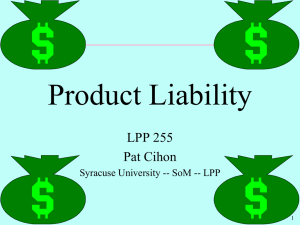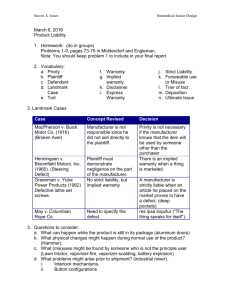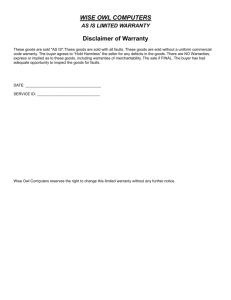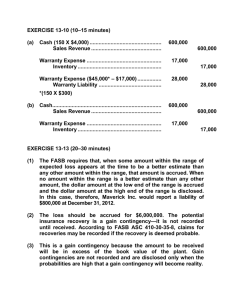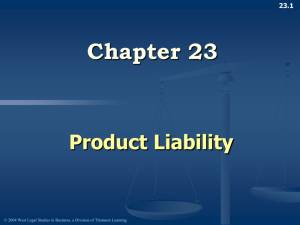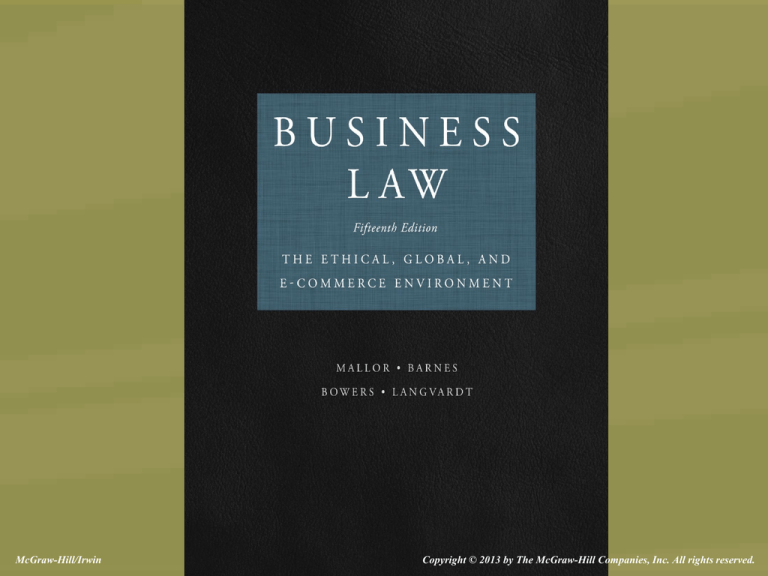
McGraw-Hill/Irwin
20-1
Copyright © 2013 by The McGraw-Hill Companies, Inc. All rights reserved.
P
A
R
T
Sales
4
• Formation and Terms of Sales Contracts
• Product Liability
• Performance of Sales Contracts
• Remedies for Breach of Sales Contracts
20-2
C H A P
T
E R
20
Product Liability
A manufacturer is not through with
his customer when a sale is
completed. He has then only
started with his customer.
Henry Ford, founder of Ford Motor
Company, in My Life and Work
(co-written with Samuel Crowther,
1922)
20-3
Learning Objectives
• Explain what is required to create an
express or implied warranty
• Identify major categories of product
liability claims based in negligence
• Differentiate strict liability claims from
those based on negligence theory
• Describe the role of comparative
negligence
20-4
Product Liability Theories
• Product liability law is partly grounded
in contract law and partly grounded in
tort law
• Contract theories are based on an
express or implied warranty
• Tort theories are based on arguments
of negligence or strict liability
20-5
Express Warranty
• UCC 2–313(1): express warranty may
be created in any of three ways:
– If affirmation of fact or promise about
goods becomes part of the basis of
the bargain
• Statements of value or opinion and sales
puffery do not constitute a warranty
• Advertisements may contain statements
of warranty as well as sales puffery
20-6
Express Warranty
• Two other express warranties:
– A description of the goods that
becomes part of the bargain
creates an express warranty that the
goods will conform to description
– A sample or model of goods to be
sold creates an express warranty
that goods will conform to sample
20-7
Implied Warranties
• Implied warranties are created by
operation of law rather than seller’s
express statements
– Warranty of merchantability [UCC 2-314(1)]
• Seller must be a merchant in the goods of the
kind sold
– Warranty of fitness for a particular purpose
[UCC section 2–315]
• Seller must know the goods are to be used for
special purpose
20-8
Implied Warranty of Merchantability
• In implied warranty cases, plaintiff
argues that seller breached warranty by
selling unmerchantable goods and
plaintiff should recover damages
– Privity of contract between consumer and
manufacturer is not required
• Merchantability, essentially, is that
goods must be fit for the ordinary
purposes for which such goods are used
20-9
Implied Warranty of
Fitness for a Particular Purpose
• Warranty of fitness for a particular purpose
implied if: (1) seller has reason to know a
particular purpose for which buyer requires
the goods; (2) seller has reason to know that
buyer is relying on seller’s skill or judgment
for the selection of suitable goods; and (3)
buyer actually relies on seller’s skill or
judgment in purchasing the goods
– See Moss v. Batesville Casket Co.
20-10
Negligence Theory
• Product liability suits based on negligence
allege that manufacturer or seller
breached a duty to plaintiff by failing to
eliminate a reasonably foreseeable risk of
harm:
– negligent manufacture of the goods (including
improper materials and packaging)
– negligent inspection
– negligent failure to provide adequate warnings
– negligent design
20-11
Strict Liability Theory
• American Law Institute published
section 402A of Restatement (Second)
of Torts (1965)
– Most important reason is socialization-of-risk
strategy: strict liability makes it easier for
plaintiffs to prove breach of duty and sellers
pass on costs in higher prices
– Another reason: stimulates manufacturers to
design and build safer products
20-12
Restatement (Third) of Torts
• Published in 1998, basic rule is: “One engaged in
the business of selling or otherwise distributing
products who sells or distributes a defective
product is subject to liability for harm to persons
or property caused by the defect.”
• Three kinds of product defects: manufacturing
defects, inadequate warnings or instructions,
design defects
20-13
Other Product Liability Theories
• Federal Magnuson-Moss Warranty Act
applies to sales of consumer products
more than $10 per item:
– If written warranty, it must be full or limited
– Full warranty promises to (1) remedy any defects
in the product and (2) replace product or refund
purchase price if, after reasonable number of
attempts, it cannot be repaired
– Seller who gives a limited warranty is bound to
whatever promises it actually makes
20-14
Other Product Liability Theories
• A seller’s misrepresentation about a material
fact about the product — a fact that would
matter to a reasonable buyer – may invoke
liability to a buyer
• Industrywide liability: plaintiffs bypass
problems of causation that exist where
several firms within an industry manufactured
a harmful standardized product, and plaintiff
cannot prove which firm produced the
injurious product
20-15
Damages
• Consequential damages: personal
injury, property damage, indirect
economic loss (e.g., lost profits or lost
business reputation), and noneconomic
loss, such as pain and suffering, physical
impairment, mental distress, loss of
enjoyment of life, loss of companionship
or consortium, inconvenience, and
disfigurement
20-16
Damages
• Basis-of-the-bargain damages:
– Buyers of defective goods loss of full value for
the goods’ purchase price is direct economic
loss (value of goods as promised under the
contract minus value of goods as received)
• Punitive damages:
– Intended to punish defendants who have
acted in an especially outrageous fashion,
and to deter them and others from so acting
in the future
20-17
Disclaimers
• Product liability disclaimer is a clause in the
sales contract whereby the seller attempts
to eliminate liability it might otherwise have
under the theories of recovery described
earlier in the chapter
• Remedy limitation is a clause attempting
to block recovery of certain damages
– Example of time limitation: “30 day
warranty”
20-18
Defenses
• Three main defenses in
a product liability suit
are the overlapping trio
of product misuse,
assumption of risk, and
contributory negligence
– What could happen on a
construction site? What
defenses would exist?
20-19
Comparative Negligence
• Most states require fact-finder to apportion
damages based on relative fault of plaintiff’s
and defendant’s percentage shares of the
total fault for the injury
– Plaintiff is awarded total provable damages
times defendant’s percentage of fault
• Green v. Ford Motor Co.: fact-finder shall
apportion fault to injured person only if fault of
injured person is a proximate cause of injuries
for which damages are sought
20-20
Preemption and
Regulatory Compliance
• Preemption defense rests on a federal
supremacy premise, that federal law
overrides state law when the two conflict
– Riegel v. Medtronic, Inc.: state claims by
plaintiffs preempted by federal statute
dealing with medical devices
• Courts mixed whether to treat regulatory
compliance as full defense or mere
factor in determining defendant’s liability
20-21
Thought Question
• What is your opinion
of product liability
lawsuits? If you were
injured by a defective
product, would you
file a lawsuit against
the manufacturer?
20-22


